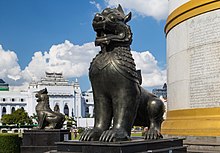Chinthe[a](Burmese:ခြင်္သေ့(IPA:[tɕʰɪ̀ɰ̃ðḛ]);Mon:ဇာဒိသိုၚ်([cɛ̀atìʔsaŋ]);Shan:သၢင်ႇသီႈ([sàːŋsi])) is theBurmeseword for 'lion'.[2][3]Theleograph[4][5]ofChintheis a highly stylizedlion[6][7]commonly depicted in Burmese iconography andarchitecture,especially as a pair of guardians flanking the entrances of Buddhistpagodasandkyaung(or Buddhist monasteries).


Natural lion
editContrary to popular belief, theChintheis not a mythical creature[8]but instead an entirely natural lion,[9]although often associated with myths and legends.
The Burmese leograph[10]is related to other stylized lions in the Asian region, including thesing(สิงห์) ofThailand,Cambodia,Laos,and thesimha(සිංහ) ofSri Lanka,where it is featured prominently on theSri Lankan rupee.It is also related to East Asian leographs, such as theguardian lionsof China,komainuof Japan,shisaof Okinawa andSnow Lionof Tibet.
Origins
editThe story of why the lions guard the entrances of pagodas and temples is given in theMahavamsa:
The princess Suppadevi ofVanga Kingdom(present dayBengal) had a son namedSinhabahuthrough her marriage to alion,but later abandoned the lion who then became enraged and set out on a road of terror throughout the lands. The son then went out to slay this terrorizing lion. The son came back home to his mother stating he slew the lion, and then found out that he killed his own father. The son later constructed a statue of the lion as a guardian of a temple to atone for his sin.[11]
In Burmese culture
editThe leograph[10]ofChintheappears as an element of Burmese iconography on many revered objects, including thepalin(Burmese royal throne) and Burmese bells.[13]
Predating the use of coins for money, brass weights cast in the shape of iconic animals like theChinthewere commonly used to measure standard quantities of staple items.[14]
In theBurmese zodiac,the lion sign is representative of Tuesday-born individuals.[15]
The leograph is featured prominently on the successive post-independence State seals (including the currentState Seal of Myanmar) and most paper denominations of theBurmese kyat,and its statues are found as guardian statues of most pagodas and temples.
Gallery
edit-
Leographic statues[16]line the rooftop at Bagan'sAnanda Temple
-
Close-up of the stylized lion head,[17]Ananda Temple
-
Temple bell in Bagan, Myanmar
-
Lion statue on Dhammayazika Pagoda, Bagan, Myanmar
-
A pair of whitewashed lions[13]guard the entrance toMandalay Hill
-
Chinthe of So Hla Waing in Bagan, Myanmar
-
Chinthe atop theMingun Bell[13]
Relation to Second World War Chindits
editDuring theSecond World War,the British BrigadierOrde Wingatewas given command of forces charged withlong-range penetrationoperations behind Japanese lines inBurma.At the suggestion of CaptainAung Thinof theBurma Rifles,Wingate decided to call this force "The Chinthes" (The Lions),[18]a name which became corrupted to "TheChindits"and was so recorded in the annals of World War II.[3]
Chinthe is also the nickname of the Canadian 435 Squadron, formed originally in 1944 in India.[19]The badge of the RCAF 435th features a chinthe on a plinth.
See also
editNotes
editReferences
edit- ^Shwedagon, Symbol of Strength and Serenity.Yangon, Burma: Yangon City Development Committee. 1997. p. 25.
- ^Myanmar-English Official Dictionary.Yangon, Burma: Department of theMyanmar Language Commission.1993. p. 79.
- ^abUnited States, Congress (1945).Hearings.Washington, USA: U.S. Government Printing Office. p. 3.
- ^Archaeological Department of Burma (1902).Report on Archaeological Work in Burma.Yangon, Burma: Superintendent, Government Printing. p. 22.
- ^Session, I.A.H Congress (1996).Proceedings of the 4th Session of Indian Art History Congress.Virginia, USA: University of Virginia. p. 100.
- ^Arts of Asia: Volume 35, Issues 1-2.Virginia, USA: AOA Publications. 2005. p. 111.
- ^Ralph Isaacs, T.Tichard Blurton (2000).Visions from the Golden Land: Burma and the Art of Lacquer.Landon, England: British Museum. p. 169.ISBN9780714114736.
- ^Sergei Sergeevich Ozhegov, Irene Moilanen (1999).Mirrorred in Wood: Burmese Art and Architecture.White Lotus Press. p. 67.ISBN9789747534009.
- ^Bunyard, Britt A. (2000).Walking to Singapore: A Year off the Beathen Path in Southeast Asia.U.S.A: Writers Club Press of iUniverse. p. 401.ISBN9781469772981.
- ^abSoutheast Asia Handbook.Michigan, USA: Moon Publications. 1994. p. 91.ISBN9781566910026.
- ^"Image 5 of 20".myanmar-image.Archived fromthe originalon 2017-04-11.Retrieved2010-09-17.
- ^Burma, Information and Broadcasting Department (1948).Burma's Fight for Freedom: Independence Commemoration.Yangon, Burma: Superintendent, Government Print. and Stationery. p. 119.
- ^abcDr., Tin Mg Oo (2005).Aspects of Myanmar Culture.Yangon, Burma: Cho-Tay-Than Bookhouse. p. 28.
- ^Shwechinthe Birmans[permanent dead link]
- ^Sir., James George Scott (1882).The Burman: His Life and Notions, Volume 2.London, England: Macmillan and Company. p. 94.
- ^The Atlas of Dream Places: A Grand Tour of the World's Best-loved Destinations.Konecky & Konecky. 2002. p. 214.ISBN9781568523576.
- ^Majumdar, Ramesh Chandra (1960).Ancient India.Delhi, India: Motilal Banarsidass (MLBD). p. 497.
- ^Duckworth, L.B (1945). Your Men in Battle: The Story of the South Staffordshire Regiment- 1939–45. Michigan, USA: Express and Star. p. 17.
- ^National Defence, Royal Canadian Air Force (2013-04-30)."435 Transport and Rescue Squadron - Royal Canadian Air Force".canada.ca.Retrieved2023-06-06.